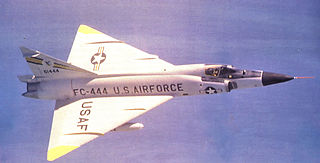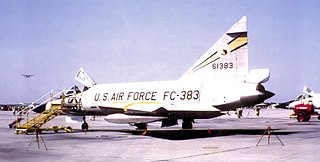
The RCA 474L Ballistic Missile Early Warning System was a United States Air Force Cold War early warning radar, computer, and communications system, for ballistic missile detection. The network of twelve radars, which was constructed beginning in 1958 and became operational in 1961, was built to detect a mass ballistic missile attack launched on northern approaches [for] 15 to 25 minutes' warning time also provided Project Space Track satellite data.

The Southeast Air Defense Sector (SEADS), was a unit of the US Air Force located at Tyndall Air Force Base near Panama City, Florida. It provided air defense and surveillance of the southeastern region of the US. SEADS closed in winter 2005, giving up surveillance and control of their airspace to the Eastern Air Defense Sector (EADS) and the former Northeast Air Defense Sector (NEADS).

Aerospace Defense Command was a major command of the United States Air Force, responsible for continental air defense. It was activated in 1968 and disbanded in 1980. Its predecessor, Air Defense Command, was established in 1946, briefly inactivated in 1950, reactivated in 1951, and then redesignated Aerospace rather than Air in 1968. Its mission was to provide air defense of the Continental United States (CONUS). It directly controlled all active measures, and was tasked to coordinate all passive means of air defense.

The 29th Air Division is an inactive United States Air Force organization. Its last assignment was with Air Defense Command, being stationed at Duluth International Airport, Minnesota. It was inactivated on 15 November 1969.

The 30th Air Division is an inactive United States Air Force organization. Its last assignment was with Air Defense Command, assigned to Tenth Air Force, being stationed at Sioux City Municipal Airport, Iowa. It was inactivated on 18 September 1968.

The 32d Air Division is an inactive United States Air Force organization. It was last active with Air Defense Command, assigned to First Air Force at Gunter Air Force Base, Alabama, where it was inactivated on 31 December 1969.

Lewistown Air Force Station is a closed United States Air Force General Surveillance Radar station. It is located 7.0 miles (11.3 km) east-southeast of Hilger, Montana. It was closed in 1971.

The 326th Fighter-Interceptor Squadron is an inactive United States Air Force unit. Its last assignment was with the 328th Fighter Wing at Richards-Gebaur Air Force Base, Missouri, where it was inactivated on 2 January 1967.
Thomasville Air Force Station is a closed United States Air Force General Surveillance Radar station. It is located 1.9 miles (3.1 km) north-northwest of Thomasville, Alabama. It was closed in 1969.

The 482d Fighter-Interceptor Squadron is an inactive United States Air Force unit. Its last assignment was with Montgomery Air Defense Sector at Homestead Air Force Base, Florida in 1969. During World War II the squadron was a replacement training unit until disbanded in 1944 when the Army Air Forces converted training units to Army Air Force Base Units. It was reconstituted in 1955 and served as a fighter interceptor squadron until 1969.

The 19th Space Operations Squadron is an Air Force Reserve space operations unit, located at Schriever Air Force Base, Colorado.
North Charleston Air Force Station is a closed United States Air Force General Surveillance Radar station. It is located in the City of North Charleston, South Carolina. It was closed in 1980.
Port Austin Air Force Station is a closed United States Air Force General Surveillance Radar station. It is located 1.2 miles (1.9 km) south-southwest Port Austin, Michigan. It was closed in 1988 by the Air Force.
Omaha Air Force Station is a closed United States Air Force General Surveillance Radar station. It is located 7.5 miles (12.1 km) north of Omaha, Nebraska. It was closed in 1968.

Madera Air Force Station is a closed United States Air Force General Surveillance Radar station. It is located 5.2 miles (8.4 km) north-northeast of Madera, California. It was closed in 1966.

Keno Air Force Station is a closed United States Air Force General Surveillance Radar station. It is located 4.6 miles (7.4 km) south-southwest of Keno, Oregon. It was closed in 1979 by the Air Force, and turned over to the Federal Aviation Administration (FAA).
Othello Air Force Station is a closed United States Air Force General Surveillance Radar station. It is located 7.2 miles (11.6 km) south of Othello, Washington. It was the home station of the 637th Aircraft Control and Warning Squadron and the 637th Air Defense Group, closing in 1975.
Mica Peak Air Force Station is a closed United States Air Force General Surveillance Radar station. It is located atop Mica Peak, 6.3 miles (10.1 km) east-northeast of Mica, Washington. It was closed in 1975 by the Air Force, and turned over to the Federal Aviation Administration (FAA).
Houma Air Force Station is a closed United States Air Force General Surveillance Radar station. It is located 3.5 miles (5.6 km) southeast Houma, Louisiana. It was closed in 1970.
Falling Leaves was an improvised ballistic missile early warning system of the United States Air Force. It was set up during the 1962 Cuban Missile Crisis, and networked 3 existing U.S. radars—2 Space Detection and Tracking System (SPADATS) radars and an Aircraft Control and Warning general surveillance radar which was modified by Sperry Corporation to 1,500 mi (2,400 km) range, allowing detection in space near Cuba. The designation was assigned by the 9th Aerospace Defense Division, headquartered at Ent AFB, Colorado.



















